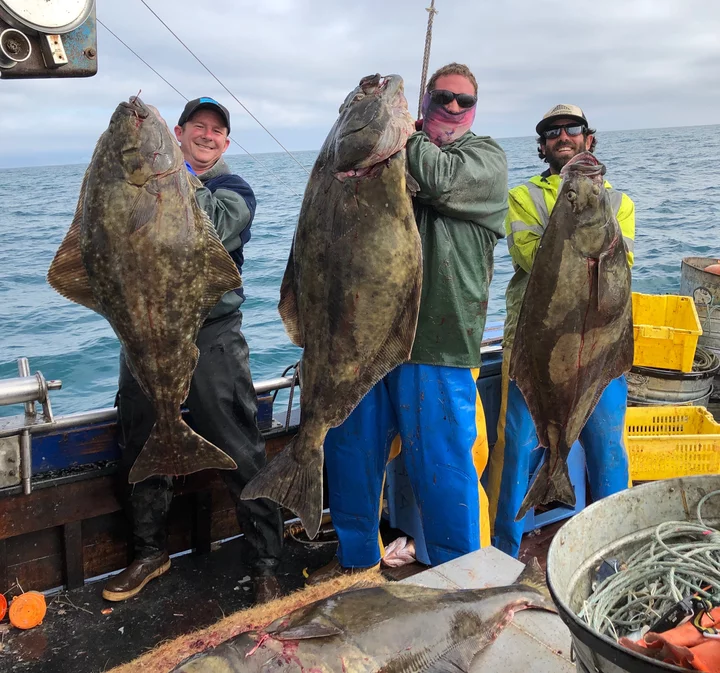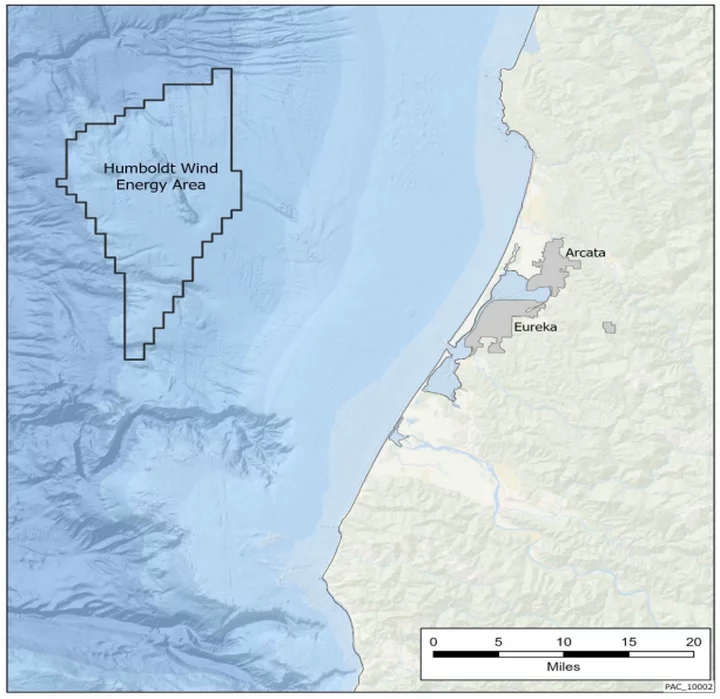Photo by Waldemar Brandt on Unsplash.
As plans to bring offshore wind to the North Coast move steadily ahead, commercial fishermen are urging federal and state regulatory agencies to pump the brakes.
“I want to make one thing clear: Fishermen are not opposing [renewable] projects up here, we’re opposing the loss of thousands of miles of fishing grounds,” Ken Bates, president of the California Fishermen’s Resiliency Association (CFRA), told the Outpost in a recent interview. “Fishermen understand what’s going on with the climate. They can see what’s going on with the ocean. They get it. … That being said, we need to exercise a little bit of caution before we just throw these projects to the wind, so to speak.”
The Humboldt Wind Energy Area (WEA) is comprised of two lease areas spanning more than 200 square miles – 28 miles north to south and about 14 miles east to west – roughly 20 miles west of Eureka, smack dab in the middle of some of the most valuable fishing grounds on the entire West Coast.
“Interestingly enough, the areas that are the windiest on the California, Oregon and Washington coasts are also the areas that are most biologically productive,” Bates said. “Some of the worst ocean conditions in the world have also been recorded off the Cape Mendocino.”
Bates has relayed his concerns to the Bureau of Ocean Energy Management (BOEM), the federal agency that oversees the development of offshore renewable energy projects, but he feels commercial fishermen aren’t being heard.
“The lease area was picked by [BOEM] without input from anybody in the fishing fleet,” he said, adding that there are only a handful of fully operational floating wind turbines in the world. “Part of what fishermen are asking for is to slow down. Let’s be careful and make sure we’re not doing more damage than we’re hoping to alleviate by implementing this technology in the ocean. …We’re scrambling to try to find a way to have some input in this process.”
Travis Hunter, president of the Fisherman’s Marketing Association, said engagement with BOEM and other federal and state agencies “has been little more than a rubber stamp.”
“You know, ‘Check the box, we talked to the fishermen!’” he told the Outpost in a recent interview. “I’m not saying that there hasn’t been an opportunity for public comment; I just don’t think it’s going anywhere and our concerns aren’t being heard. … It seems like there is a push to get this done no matter what. You’ve got to break a few eggs to make an omelet and, well, we’re going to be the broken eggs.”
If the offshore wind development moves forward as planned, many local fishermen – particularly the trawl and ground fishing fleets – would lose access to grounds they’ve fished for decades.
“The trawl fleet has fished in and around the Humboldt [WEA] for generations and we’re gonna lose a lot of ground,” Hunter continued. “We may very well lose more of that area depending on how developers construct the transmission lines connecting the operation to the shore. There are a lot of unknowns in this and, sure, there are some fishermen in the area that will be much less impacted and there are mitigation measures for them, but not for all.”
Harrison Ibach, president of the Humboldt Fisherman’s Marketing Association, worries that the offshore wind development could impact upwelling, the process in which currents bring cold, nutrient-rich water from the depths of the ocean to its surface, replacing warm, nutrient-deficient water.
Preliminary results from a recent study of the Morro Bay and Humboldt Call Areas found large-scale offshore wind energy projects “[have] the potential to reduce the wind stress at the sea surface” which could adversely impact upwelling, nutrient delivery and ecosystem dynamics along the Pacific Coast. However, the study notes that changes to wind speeds in the Humboldt Bay Call Area “are substantially smaller than those seen near Morro Bay.”
Oceana Hooknline Seafood crew, with halibut. Photo courtesy Harrison Ibach.
“We have a very healthy ocean along our coast because we have a lot of upwelling that comes from bad weather and a lot of wind,” Ibach told the Outpost. “Fishing grounds that are that productive and that close to port are really important because you’re not looking to travel very long distances when you’re fishing in bad weather.”
As one might guess, these are the same reasons that that particular swath of sea is appealing for offshore wind development. Once construction begins, Ibach fears fleets will have to compete with developers to fish.
“We’re really concerned about the amount of traffic that will be taking place,” he said. In this case, “traffic” refers to the vessels that will be used to bring the wind turbines, which will be assembled at a full-service terminal on the Samoa Peninsula, through Humboldt Bay and out to the Humboldt WEA. “We don’t get a lot of good fishable days out of Humboldt Bay, so we may be competing with offshore wind [developers] for the best fishing weather.”
BOEM released a Finding of No Significant Impact (FONSI) and the Final Environmental Assessment (EA) for the project earlier this year. Among other things, the FONSI determined that impacts to commercial and recreational fisheries “are expected to range from negligible to minor.”
“Marine vessels mobilizing and transiting from ports to the WEA may reduce efficiency of fishing operations due to time delays associated with congestion, but the [port] and its nearshore waters hosts a variety of marine operations and hundreds of fishers, so the expected increase in activity from project vessels would be small compared to the overall level of work,” the document states. “Potential effects to commercial fishing from the collection buoys are expected to be temporary in duration (five years or less) and would be limited to a small area of the WEA (around the buoys).”
The environmental review process still has a long way to go. After the upcoming lease auction (more on that below) BOEM will select two winning bidders. The leaseholders will then begin the “construction and operations phase” and conduct further analysis through an Environmental Impact Statement (EIS) or an Environmental Impact Report (EIR).
North Coast fisheries could receive a chunk of funding from developers to make up for lost fishing grounds and other disruptions to commercial fishing efforts.
For example, developers associated with Vineyard Wind, an offshore wind energy project currently under construction off the coast of Massachusetts, created a compensation package to reimburse impacted commercial fishermen and to fund studies and projects to improve conditions for fish in and around the facility. Developers also agreed to bury transmission cables deep enough to allow for fishing above them and to align the wind turbines in an east-west direction to better accommodate boat traffic.
The Redwood Region Climate & Community Resilience (CORE) Hub and the North Coast Offshore Wind Community Benefits Network (the Network) – a coalition of local governments, districts and agencies, tribes, environmental advocacy groups and community-based organizations – are hoping to do something similar through a bid credit package.
The future site of the floating offshore wind farm. Map: Bureau of Ocean Energy Management
The bid credit package will be made available through an upcoming lease auction in which 43 separate entities, ranging from regional LLCs all the way up to energy giants like Shell, will bid for five lease areas along the West Coast, two of which are in the Humboldt WEA. To qualify for the credit package the bidder “must commit to mak[ing] a qualifying monetary contribution to programs or initiatives” that benefit the greater Humboldt County community.
“A bidder may target either workforce training, supply chain development, or a combination thereof for a 20 percent credit,” according to the Final Sale Notice (FSN) for the Humboldt WEA. “The Lease Area Use Community Benefits Agreement (CBA) bidding credit will be worth 5 percent of the cash bid. The General CBA bidding credit will be worth 5 percent of the cash bid.”
That means up to 30 percent of the final cash bid that is accepted during the upcoming auction could be set aside to offset impacts associated with offshore wind development.
However, the bid credit is not guaranteed. Bidders can choose to opt out of the credit on the Bidder’s Financial Form.
“Everybody is making this giant assumption that these credits are mandatory and they’re not,” Bates said. “It’s my personal opinion that fishermen won’t see any of that money from those bid credits because of the restrictive language in [the CBA]. … I wouldn’t bet on it for a second.”
Instead of counting on financial relief for fisheries, Bates suggested a three-pronged approach: avoidance, minimization and mitigation.
“What can we do to avoid the impacts that we perceive are coming?” he asked. “Part of that might be in the short-term, such as limiting wind power areas across California for the next five years or so until we see how this stuff works. … Another part of ‘avoidance’ would be working with fisheries to try to locate areas that are more important than others, but that’s always been controversial because fish move and fishermen move with them.”
The second piece, “minimization,” would seek to reduce impacts associated with offshore wind. The California Fishermen’s Resiliency Association is working on a list of things that developers and fisheries can do to work together to minimize impacts.
“That includes things like seasonality and when they might be moving turbine units on and off the fishing grounds,” Bates said. “Or, the route of the cable lanes. These turbine arrays are going to have multiple cables – anywhere from five to 12 cables – and they have to be far apart.”
The final component is “mitigation,” he said. “Mitigation is when you can’t figure out any other way to fix the problem you’ve created. At that point, it comes down to cash and that will just be a bandaid.”
BOEM did not respond to the Outpost’s request for comment regarding the fishing fleet’s apprehension.
The County of Humboldt, on the other hand, acknowledged the fleet’s “legitimate concerns about access to fishing grounds and other impacts of offshore wind development,” and emphasized the importance of a robust public process.
“While the County has little direct control over the offshore wind development process, we have been working hard to represent and support local residents, communities, and industries to ensure that offshore wind development provides community benefits, minimizes and mitigates any unavoidable impacts, and generates significant economic opportunity for the region,” Humboldt County spokesperson Sean Quincey wrote in a recent email to the Outpost. “Offshore wind energy is a key strategy to fight global climate change, and we look forward to working directly with project developers to build a sustainable approach in conjunction with local and regional stakeholders.”
The Dec. 6 lease auction is the next big step for offshore wind development. The provisional winners and the winning bid amounts will be published shortly after the auction.
Once the post-auction review is completed sometime in March 2023, BOEM will send off three unsigned copies of the lease to each provisionally winning bidder who must sign the lease agreement, file financial assurance and pay off any outstanding balance of their bonus bid within 10 days.
“At least we’ll know what companies we’re dealing with at that point,” Bates said. “Our position is to try to work with these potential developers [to] avoid as many impacts as possible. That’s where we are right now.”
More information on the lease auction can be found here.
###
DOCUMENTS:
PREVIOUSLY:
- Biden Administration Proposes Offshore Wind Lease Sale, Including Two Spots Off the Humboldt County Coast
- IT’S ON: Humboldt Offshore Wind Leases to Go Up For Auction on Dec. 6
- Harbor District Announces Massive Offshore Wind Partnership; Project Would Lead to an 86-Acre Redevelopment of Old Pulp Mill Site
- Offshore Wind is Coming to the North Coast. What’s in it For Humboldt?



CLICK TO MANAGE